
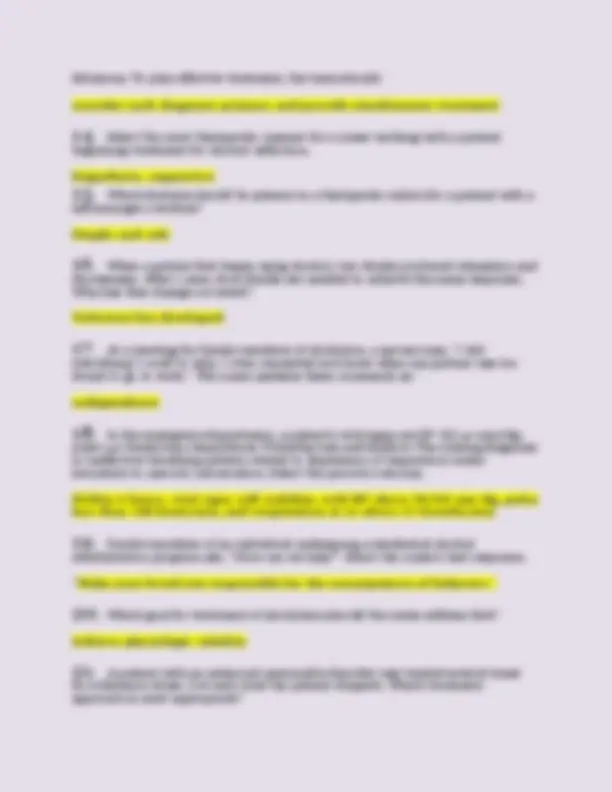
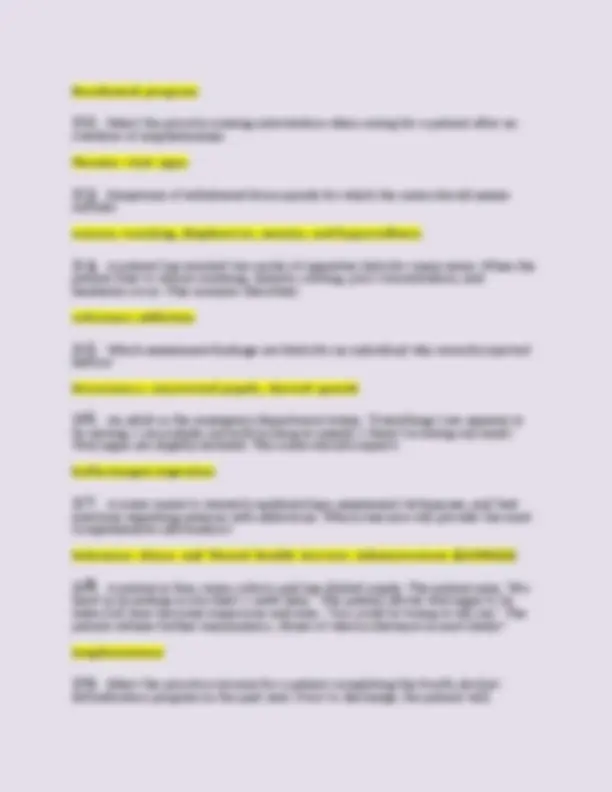
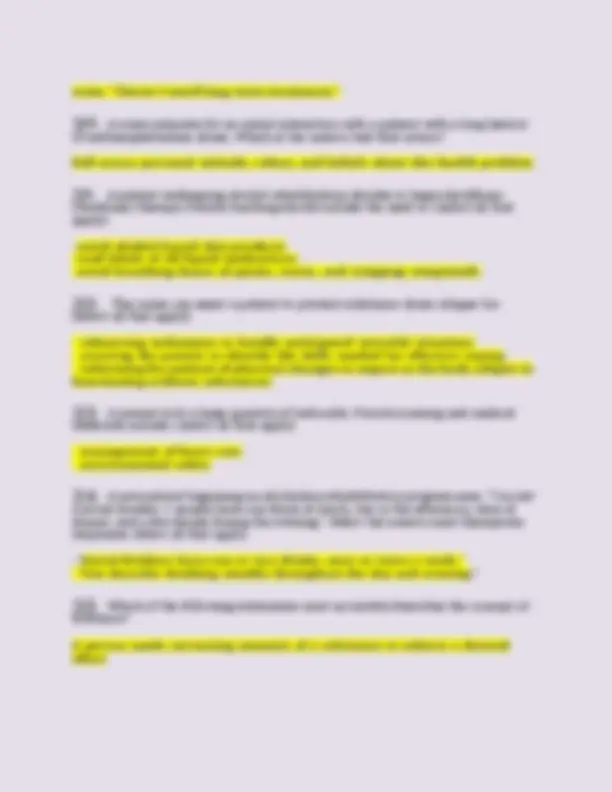
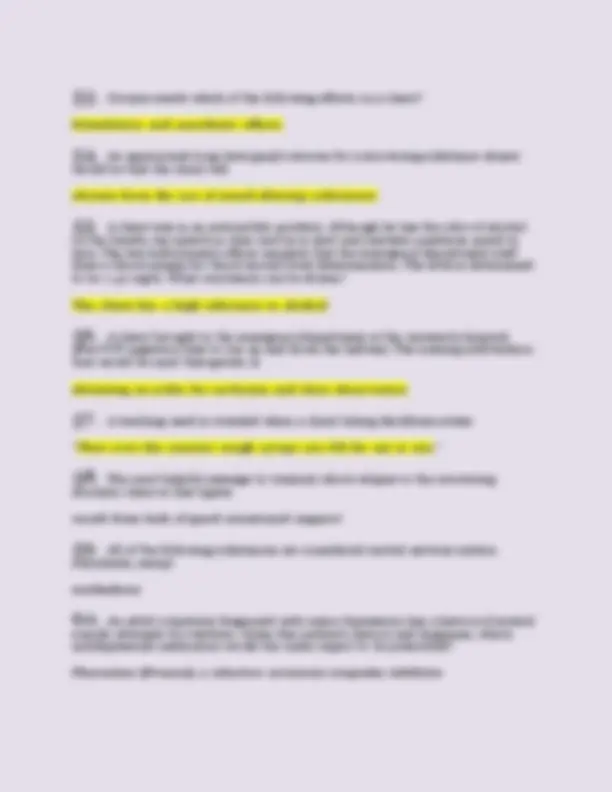
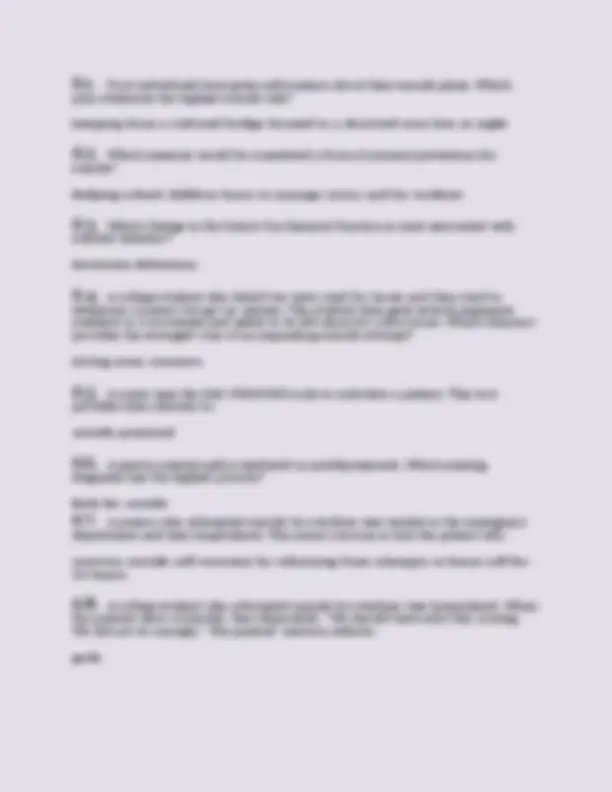
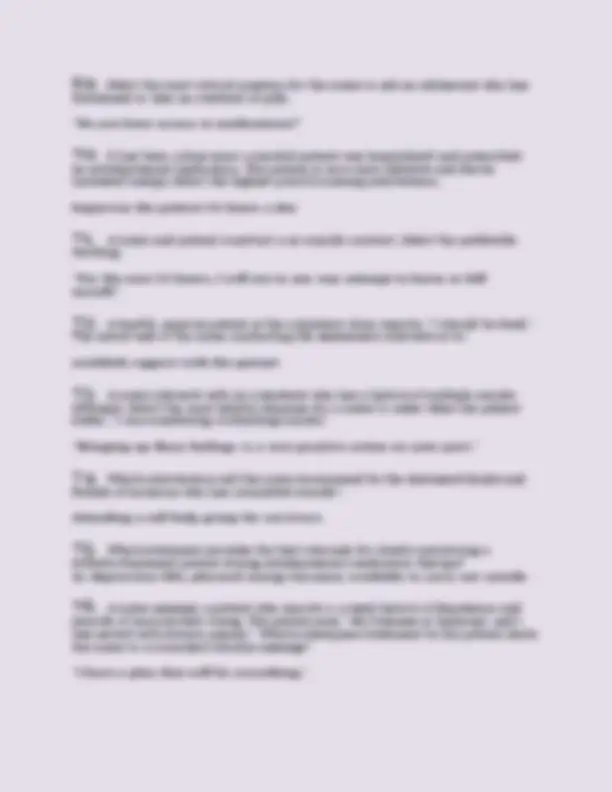
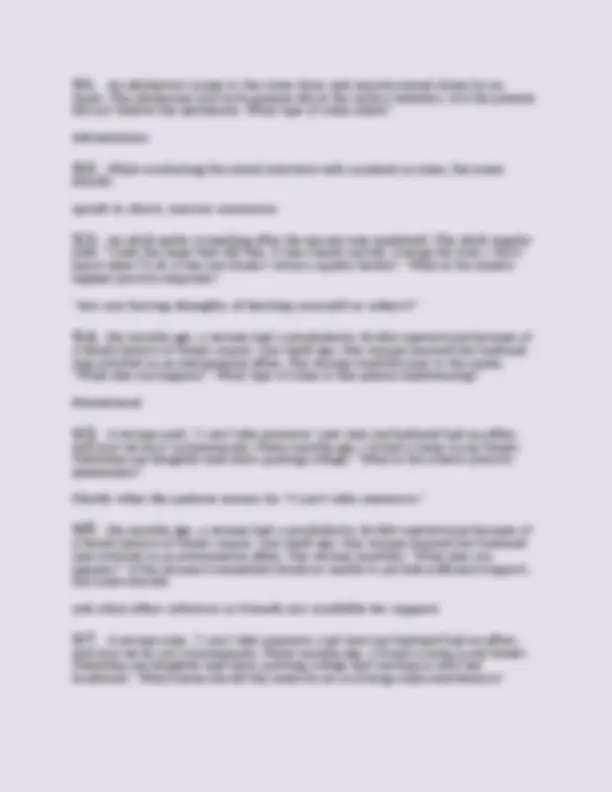
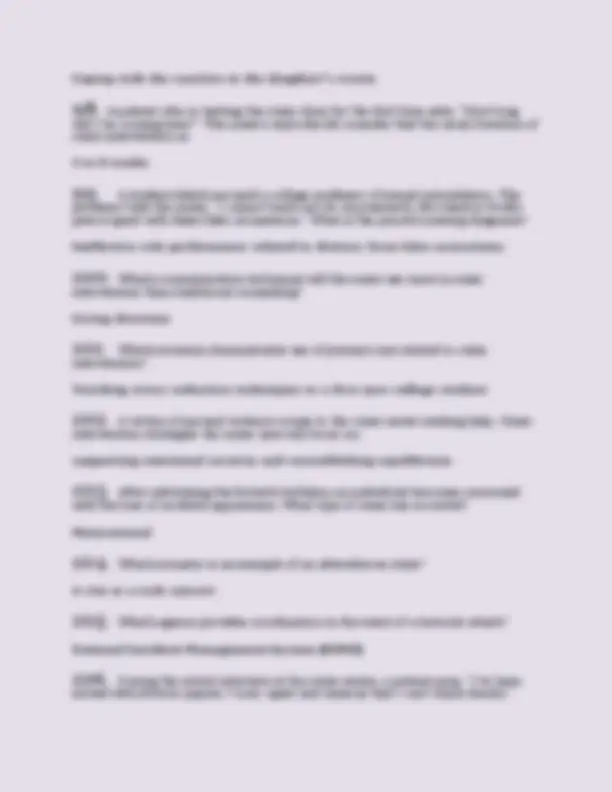
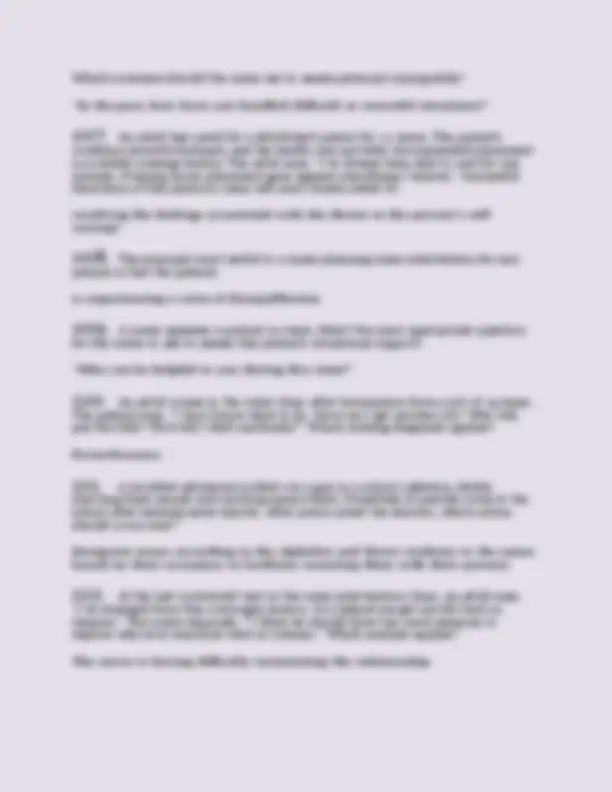
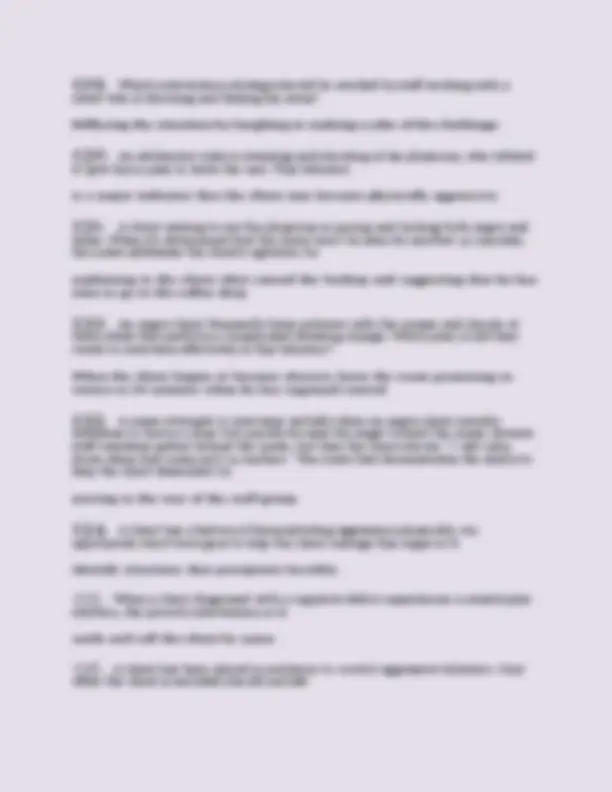
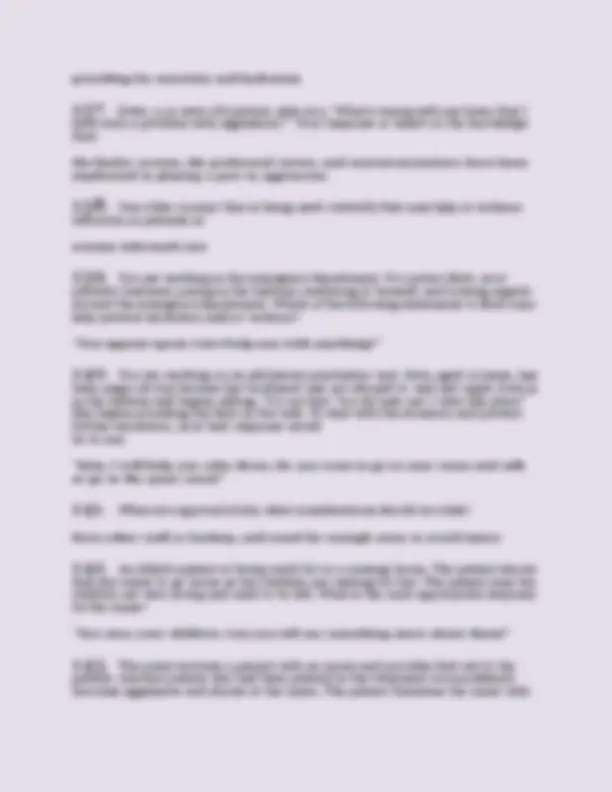
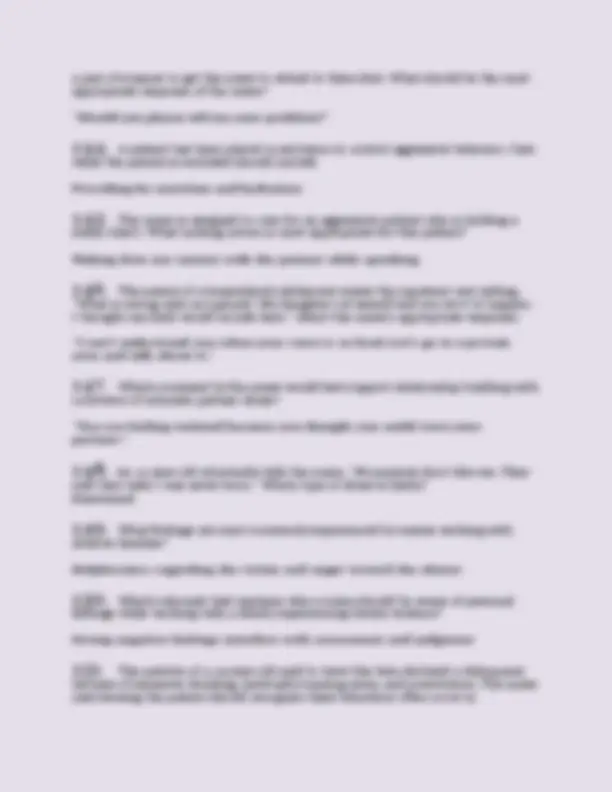
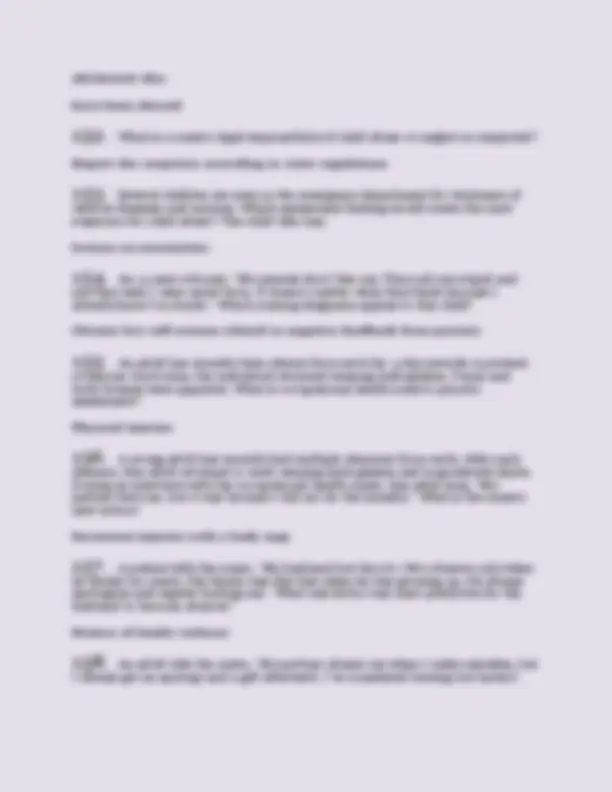
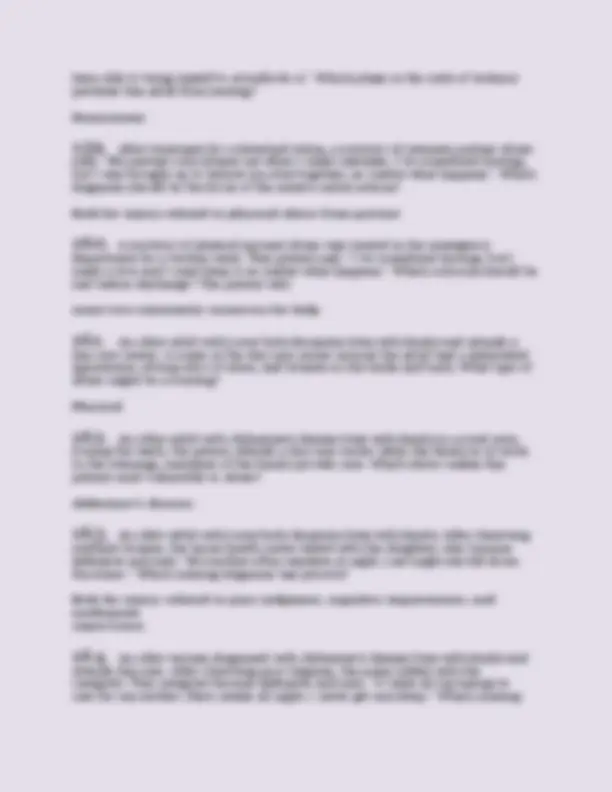
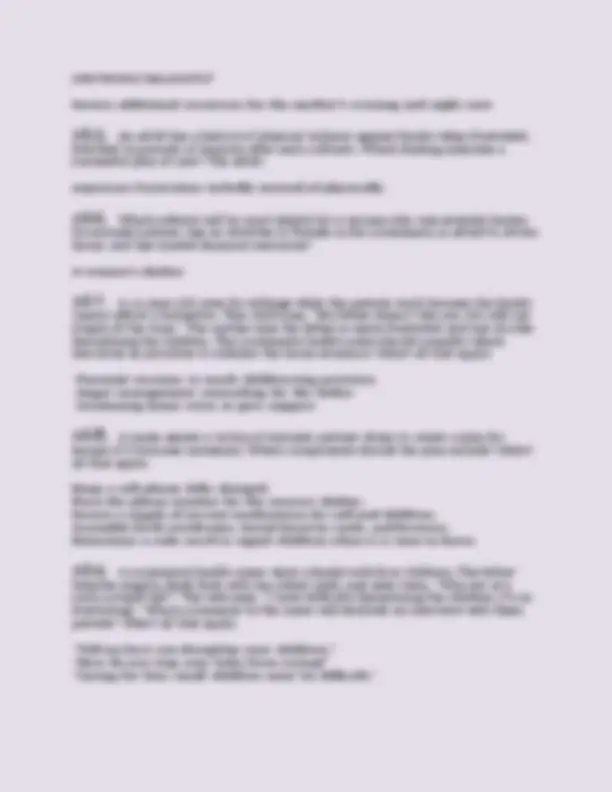
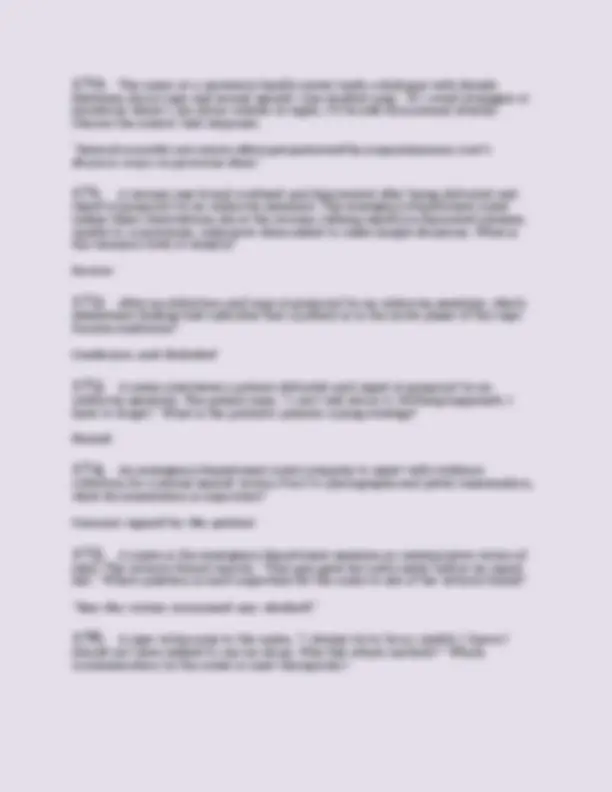
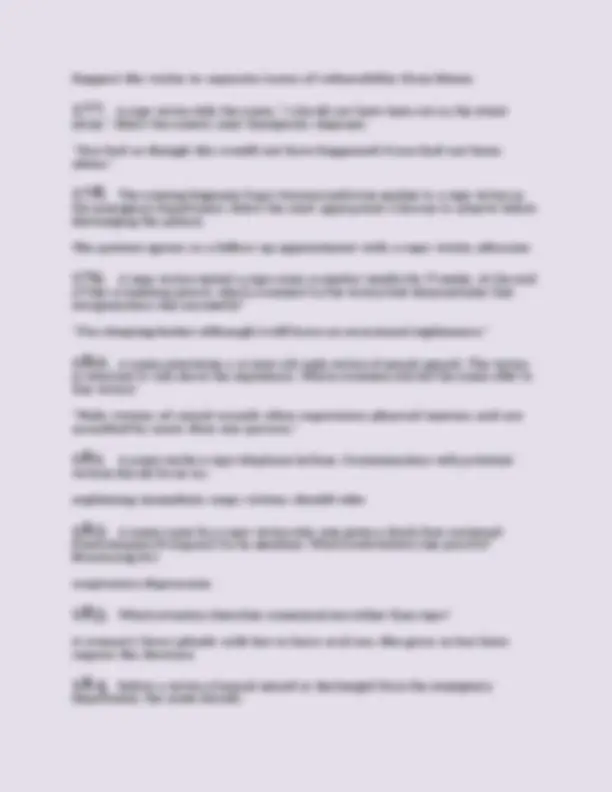
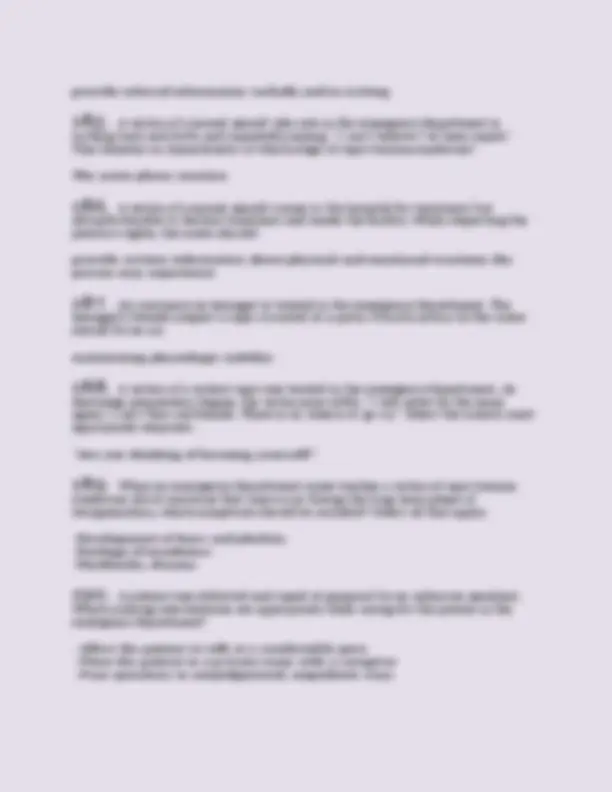
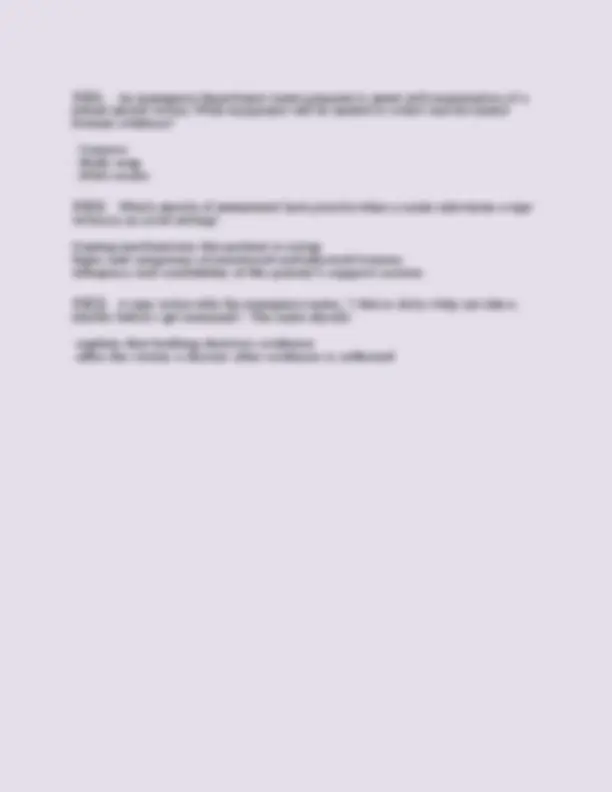


Study with the several resources on Docsity

Earn points by helping other students or get them with a premium plan


Prepare for your exams
Study with the several resources on Docsity

Earn points to download
Earn points by helping other students or get them with a premium plan
Community
Ask the community for help and clear up your study doubts
Discover the best universities in your country according to Docsity users
Free resources
Download our free guides on studying techniques, anxiety management strategies, and thesis advice from Docsity tutors
Various scenarios involving patients with substance abuse and mental health disorders, including alcohol withdrawal, opioid overdose, alcohol abuse, and schizophrenia with cannabis abuse. It covers topics such as therapeutic responses, medication management, relapse prevention, and the nurse's role in assessment, intervention, and patient education. Insights into the complex interplay between substance abuse and mental health, highlighting the importance of a comprehensive, patient-centered approach to care. The information presented can be valuable for healthcare professionals, particularly nurses, in understanding the challenges and best practices in managing patients with these co-occurring conditions.
Typology: Exams
1 / 27

This page cannot be seen from the preview
Don't miss anything!




















A patient diagnosed with alcoholism asks, "How will Alcoholics Anonymous (AA) help me?" Select the nurse's best response. "An individual is supported by peers while striving for abstinence one day at a time."
while intoxicated. The medical record shows these blood pressure and pulse readings at the times listed: 0200: 118/78 mm Hg and 72 beats/min 0400: 126/80 mm Hg and 76 beats/min 0600: 128/82 mm Hg and 72 beats/min 0800: 132/88 mm Hg and 80 beats/min 1000: 148/94 mm Hg and 96 beats/min What is the nurse's priority action? Consult the health care provider
assessment has the highest priority? Respiratory
hospitalized for 48 hours. The patient is now shaky, irritable, anxious, diaphoretic, and reports nightmares. The pulse rate is 130 beats/min. The patient shouts, "Bugs are crawling on my bed. I've got to get out of here." Select the most accurate assessment of this situation. The patient: has symptoms of alcohol-withdrawal delirium
bugs are crawling on the bed. The patient is anxious, agitated, and diaphoretic. What is the priority nursing diagnosis? Risk for injury
window blinds are snakes trying to get in the room. The patient is anxious, agitated, and diaphoretic. The nurse can anticipate the health care provider will prescribe a(n): sedative, such as lorazepam (Ativan) or chlordiazepoxide (Librium)
spiders are spinning entrapping webs in the room. The patient is fearful, agitated, and diaphoretic. Which nursing intervention is indicated? One-on-one supervision
cope with being a single parent." Which therapeutic response by the nurse would help the patient conceptualize the drinking objectively? "Tell me what happened the last time you drank."
best response. "Alcoholics Anonymous is a: “self-help group for which the goal is sobriety."
accident. The patient demonstrates ataxia and slurred speech. The blood alcohol level is 500 mg%. Considering the relationship between the behavior and blood alcohol level, which conclusion is most probable? The patient: has a high tolerance to alcohol
"I'm actually just a social drinker. I usually have a drink at lunch, two in the afternoon, wine with dinner, and a few drinks during the evening." The patient is using which defense mechanism? Denial
patients with an addiction to either alcohol or opioids? Naltrexone (ReVia)
rehabilitation program for substance abuse says, "After this treatment program, I think everything will be all right." Which remark by the nurse will be most helpful to the spouse? "While sobriety solves some problems, new ones may emerge as one adjusts to living without drugs and alcohol."
schizophrenia and daily cannabis abuse who is having increased hallucinations and
Residential program
overdose of amphetamines. Monitor vital signs
include: nausea, vomiting, diaphoresis, anxiety, and hyperreflexia
patient tries to reduce smoking, anxiety, craving, poor concentration, and headache occur. This scenario describes: substance addiction
heroin? Drowsiness, constricted pupils, slurred speech
be waving. I am outside my body looking at myself. I think I'm losing my mind." Vital signs are slightly elevated. The nurse should suspect: hallucinogen ingestion
practices regarding persons with addictions. Which resource will provide the most comprehensive information? Substance Abuse and Mental Health Services Administration (SAMHSA)
heart is pounding in my chest. I need help." The patient allows vital signs to be taken but then becomes suspicious and says, "You could be trying to kill me." The patient refuses further examination. Abuse of which substance is most likely? Amphetamines
detoxification program in the past year. Prior to discharge, the patient will:
state, "I know I need long-term treatment."
of methamphetamine abuse. Which is the nurse's best first action? Self-assess personal attitude, values, and beliefs about this health problem
(Antabuse) therapy. Patient teaching should include the need to: (select all that apply)
**- avoid alcohol-based skin products
(select all that apply)
**- rehearsing techniques to handle anticipated stressful situations
measures include: (select all that apply)
**- management of heart rate
a social drinker. I usually have one drink at lunch, two in the afternoon, wine at dinner, and a few drinks during the evening." Select the nurse's most therapeutic responses. Select all that apply.
**- "Social drinkers have one or two drinks, once or twice a week."
tolerance? A person needs increasing amounts of a substance to achieve a desired effect
narcotic compared with the ethical obligation when the nurse observes a peer to be under the influence of alcohol? Supervisory staff should be informed as soon as possible in both cases
to the emergency department with the report that although she has no recollection of the incident, she believes she was sexually assaulted at a party? GHB
the following interventions is the first priority for a safe recovery? The client strives to maintain abstinence
lacrimation, rhinorrhea, dilated pupils, and muscle aches
responsible for withdrawal symptoms requiring both medical intervention and nursing support? Barbiturates
last drink would most likely reveal the presence of tremors
started freebasing. For the past week she has locked herself in her apartment and has used $8000 worth of cocaine. When brought to the hospital she was unconscious. Nursing measures should include observation for hyperpyrexia and seizures
admitting diagnosis is "rule out opiate overdose." Which item of assessment data would be most consistent with opiate overdose? Blood pressure, 80/40 mm Hg; pulse, 120 beats/min; respirations, 10 breaths/min
Stimulation and anesthetic effects
would be that the client will abstain from the use of mood-altering substances
on his breath, his speech is clear and he is alert and answers questions posed to him. The law enforcement officer requests that the emergency department staff draw a blood sample for blood alcohol level determination. The level is determined to be 0.30 mg%. What conclusion can be drawn? The client has a high tolerance to alcohol
after PCP ingestion tries to run up and down the hallway. The nursing intervention that would be most therapeutic is obtaining an order for seclusion and close observation
"Most over-the-counter cough syrups are OK for me to use."
alcoholic client is that lapses result from lack of good situational support
stimulants, except methadone
suicide attempts by overdose. Given this patient's history and diagnosis, which antidepressant medication would the nurse expect to be prescribed? Fluoxetine (Prozac), a selective serotonin reuptake inhibitor
threatened to take an overdose of pills. "Do you have access to medications?"
an antidepressant medication. The patient is now more talkative and shows increased energy. Select the highest priority nursing intervention. Supervise the patient 24 hours a day
wording. "For the next 24 hours, I will not in any way attempt to harm or kill myself."
The initial task of the nurse conducting the assessment interview is to: establish rapport with the patient
attempts. Select the most helpful response for a nurse to make when the patient states, "I am considering committing suicide." "Bringing up these feelings is a very positive action on your part."
friends of someone who has committed suicide? Attending a self-help group for survivors
severely depressed patient during antidepressant medication therapy? As depression lifts, physical energy becomes available to carry out suicide
periods of uncontrolled crying. The patient says, "My business is bankrupt, and I was served with divorce papers." Which subsequent statement by the patient alerts the nurse to a concealed suicidal message? "I have a plan that will fix everything."
appropriate response by the nurse? "Are you having thoughts of suicide?"
most therapeutic comment? "Let's consider which problems are very important and which are less important."
Availability of means and lethality of method
most predictive of elevated suicide risk is hopelessness
need for immediate, active intervention? "I have no one to turn to for help or support."
initial nursing measure will be most important regarding this event? Hold a staff meeting to express feelings and plan care for the other patients
express concern that the other twin may also have suicidal tendencies. Which reply should the nurse provide? "Genetics are associated with suicide risk. Monitoring and support are important."
highest risk for completing suicide? A 79 - year-old single, white male diagnosed recently with terminal cancer of the prostate
uncle. The adolescent told both parents about the uncle's behavior, but the parents did not believe the adolescent. What type of crisis exists? Adventitious
should: speak in short, concise sentences
says, "I hate the beast that did this. It has ruined my life. During the trial, I don't know what I'll do if the jury doesn't return a guilty verdict." What is the nurse's highest priority response? "Are you having thoughts of hurting yourself or others?"
a family history of breast cancer. One week ago, this woman learned her husband was involved in an extramarital affair. The woman tearfully says to the nurse, "What else can happen?" What type of crisis is this person experiencing? Situational
and now we don't communicate. Three months ago, I found a lump in my breast. Yesterday my daughter said she's quitting college." What is the nurse's priority assessment? Clarify what the patient means by "I can't take anymore."
a family history of breast cancer. One week ago, this woman learned her husband was involved in an extramarital affair. The woman tearfully, "What else can happen?" If the woman's immediate family is unable to provide sufficient support, the nurse should: ask what other relatives or friends are available for support
and now we do not communicate. Three months ago, I found a lump in my breast. Yesterday my daughter said she's quitting college and moving in with her boyfriend." Which issue should the nurse focus on during crisis intervention?
Coping with the reaction to the daughter's events
will I be coming here?" The nurse's reply should consider that the usual duration of crisis intervention is: 4 to 8 weeks
professor tells the nurse, "I cannot teach nor do any research. My mind is totally preoccupied with these false accusations." What is the priority nursing diagnosis? Ineffective role performance related to distress from false accusations
intervention than traditional counseling? Giving direction
intervention? Teaching stress reduction techniques to a first-year college student
intervention strategies the nurse uses will focus on: supporting emotional security and reestablishing equilibrium
with the loss of youthful appearance. What type of crisis has occurred? Maturational
A riot at a rock concert
National Incident Management System (NIMS)
served with divorce papers. I'm so upset and anxious that I can't think clearly."
debriefing? An emergency medical technician (EMT) who treated victims of a car bombing at a mall
accident. The driver gets out of the car with no apparent physical injuries. Which assessment findings would the nurse expect from the driver immediately after this event? Select all that apply.
**- Difficulty using a cell phone
devastates many homes and businesses. The nurses provide emergency supplies of insulin to persons with diabetes and help transfer patients in skilled nursing facilities to sites that have electrical power. Which aspects of disaster management have these nurses fulfilled? Select all that apply.
**- Mitigation
natural disaster. What is the workers' first action? Report to the incident command system (ICS) center.
a normal response to a perceived threat
a staff member telling him that he is inappropriate
admitted client? A recent assault on a drinking companion
displays considerable anger and occasional aggression? Risk for other-directed violence
impulsive aggression? Low levels of serotonin
help the client reframe the anger-producing situation
anger and aggression begin as feelings of vulnerability
client who is demonstrating escalating anger? Walk the client to his room and help him practice stress-reduction techniques, such as deep breathing or muscle relaxation
the less likely it is to be therapeutic
out of control is seclusion
has delusions of persecution
at clients and staff, and shouts, "This food is garbage! I'll fight anyone who says it's not!" The nurse's most relevant assessment is that the client has a high potential for other-directed violence
providing for nutrition and hydration
have such a problem with aggression?" Your response is based on the knowledge that: the limbic system, the prefrontal cortex, and neurotransmitters have been implicated in playing a part in aggression
reduction in patients is: trauma-informed care
patient's husband, pacing in the hallway, muttering to himself, and looking angrily around the emergency department. Which of the following statements to Matt may help prevent escalation and/or violence? "You appear upset. Can I help you with anything?"
been angry all day because her boyfriend was not allowed to visit last night. Katy is in the hallway and begins yelling, "It's not fair! You all hate me! I hate this place!" She begins pounding her fists on the wall. To deal with the situation and prevent further escalation, your best response would be to say: "Katy, I will help you calm down. Do you want to go to your room and talk or go to the quiet room?"
Have other staff as backup, and stand far enough away to avoid injury
that she wants to go home as her children are waiting for her. The patient says the children are very young and need to be fed. What is the most appropriate response by the nurse? "You miss your children. Can you tell me something more about them?"
patient. Another patient who had been present in the treatment room suddenly becomes aggressive and shouts at the nurse. The patient threatens the nurse with
a pair of scissors to get the nurse to attend to them first. What should be the most appropriate response of the nurse? "Would you please tell me your problem?"
while the patient is secluded should include Providing for nutrition and hydration
sharp object. What nursing action is most appropriate for this patient? Making firm eye contact with the patient while speaking
"What is wrong with you people? My daughter cut herself and you let it to happen. I thought my child would be safe here." Select the nurse's appropriate response. "I can't understand you when your voice is so loud. Let's go to a private area and talk about it."
a survivor of intimate partner abuse? "You are feeling violated because you thought you could trust your partner."
said they wish I was never born." Which type of abuse is likely? Emotional
abusive families? Helplessness regarding the victim and anger toward the abuser
feelings while working with a family experiencing family violence? Strong negative feelings interfere with assessment and judgment
because of excessive drinking, habitually running away, and prostitution. The nurse interviewing the patient should recognize these behaviors often occur in